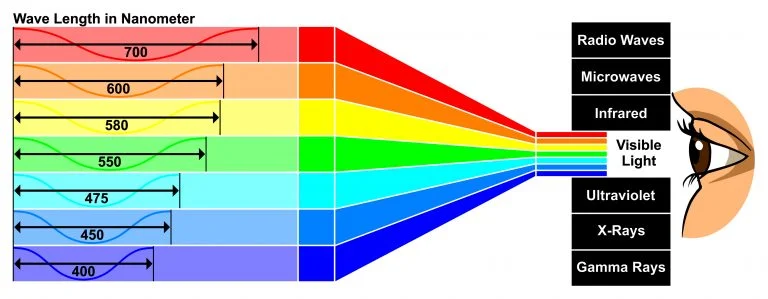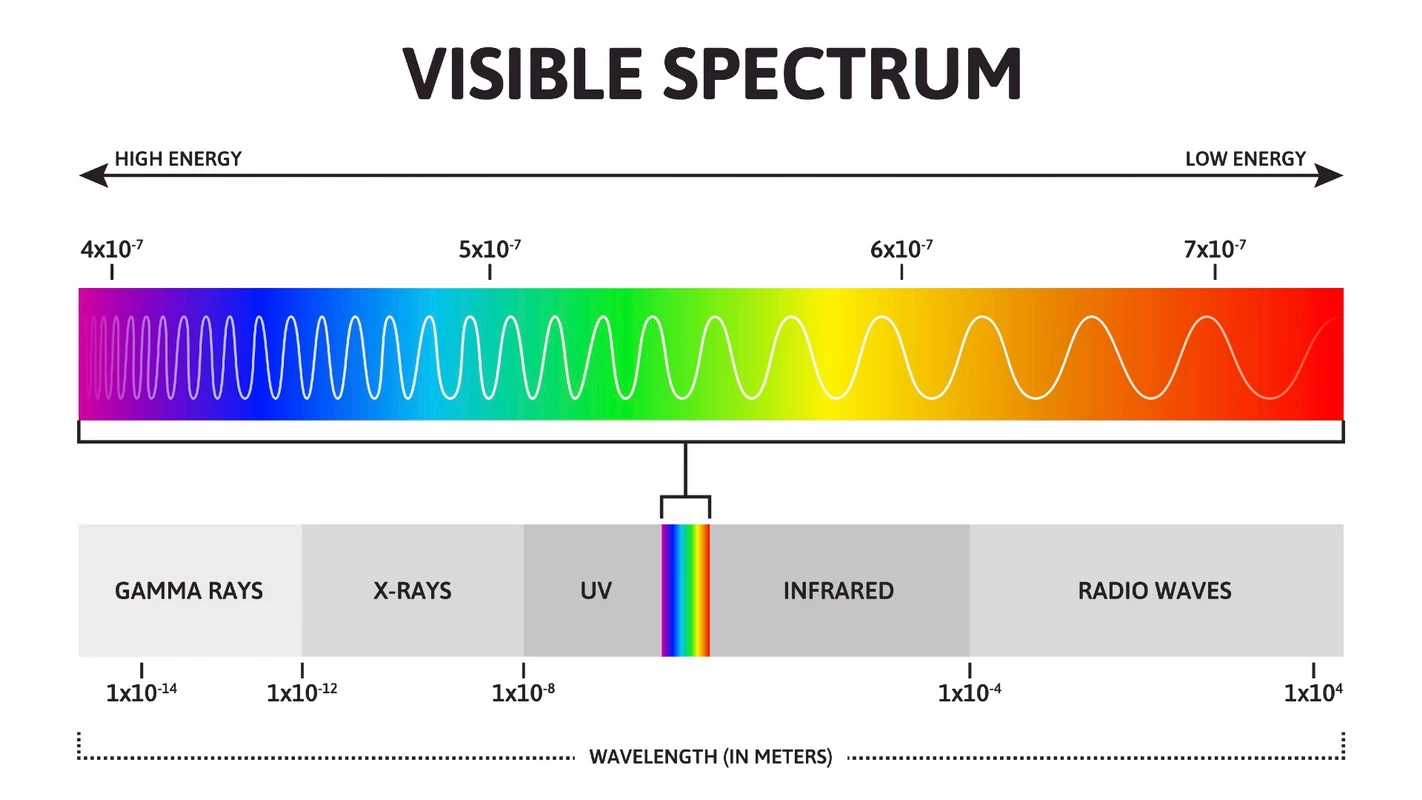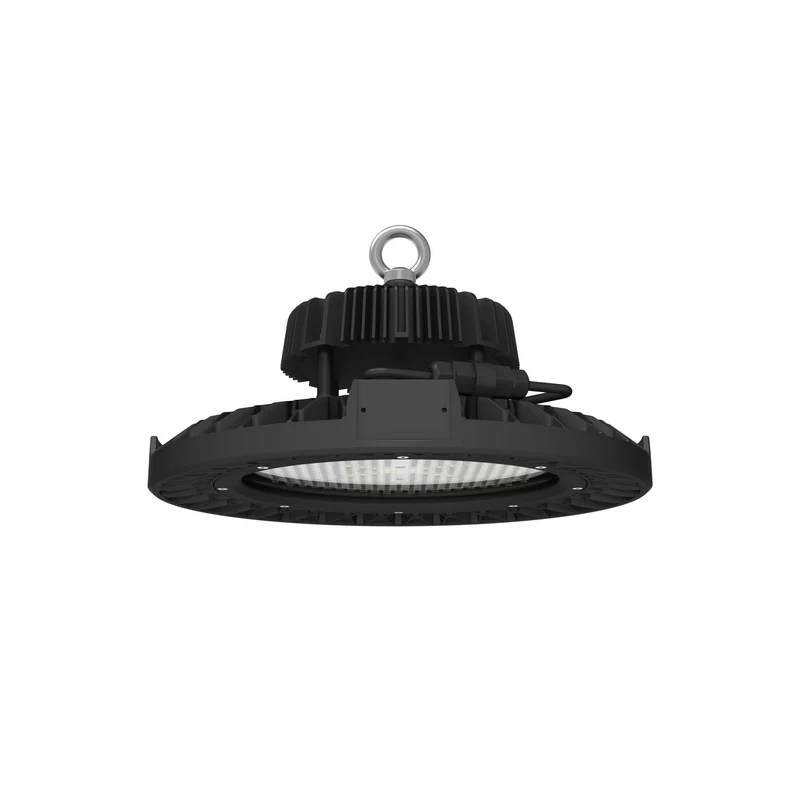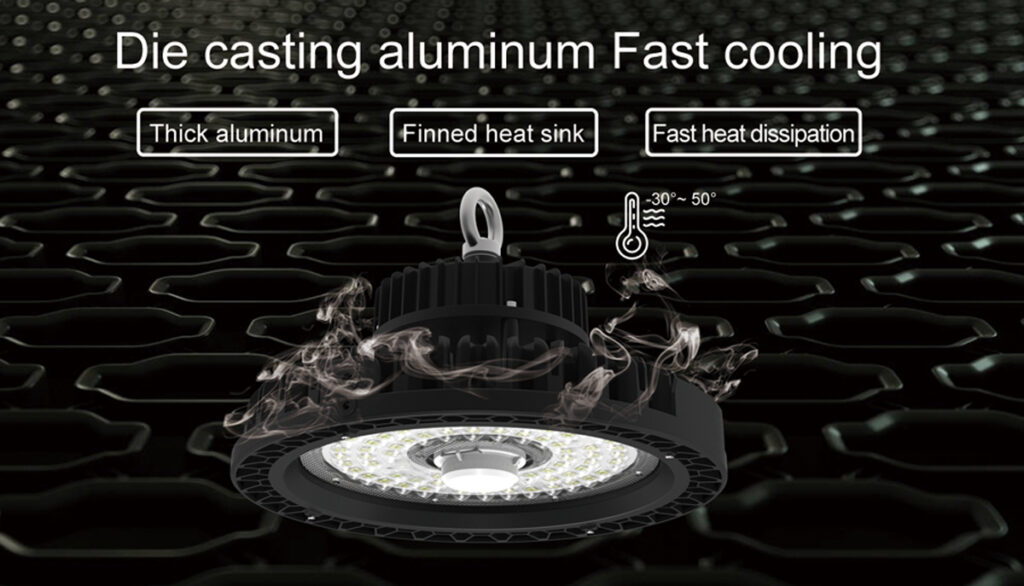Índice
AlternarDefinição de luz visível
A luz visível é um tipo de ondas electromagnéticas que é visível ao olho humano. Os comprimentos de onda da luz visível variam entre 380 e 750 nm, o espetro eletromagnético está distribuído continuamente, mas apenas os comprimentos de onda dentro desta gama podem ser vistos pelo olho humano. E cada comprimento de onda corresponde a uma cor específica.
- Os factos sobre a luz visível dizem-nos que ela é responsável pelas cores que vemos e que, sem ela, não seríamos capazes de perceber os objectos.
- O que é a luz visível? É a parte do espetro eletromagnético que os seres humanos conseguem detetar. Situa-se entre a luz ultravioleta e a luz infravermelha.

Comprimento de onda da luz visível
A gama de comprimentos de onda da luz visível é de 380-750nm (alguns dizem 400-700nm). Situa-se entre a luz ultravioleta e a luz infravermelha no espetro eletromagnético, correspondendo às várias cores de luz que vemos na nossa vida.
- A luz com comprimento de onda inferior a 380 nm é a luz ultravioleta, que é invisível ao olho humano;
- A luz com comprimento de onda superior a 750 nm é a luz infravermelha, que também é invisível.

Entre a luz visível, o vermelho tem o maior comprimento de onda e o violeta tem o menor comprimento de onda. Tabela de exemplos de alcance da luz visível:
| Cor | Gama de comprimentos de onda da luz visível (nm) | Comprimento de onda central | Caraterísticas |
|---|---|---|---|
| Violeta | 380 - 435 | 415 | Comprimento de onda mais curto, alta energia, ultravioleta próximo |
| Azul | 435 - 485 | 470 | Cor fria, comum no céu e no oceano |
| Ciano | 485 - 500 | 492 | Cor de transição azul-verde, cor do oceano |
| Verde | 500 - 565 | 535 | Um dos comprimentos de onda mais sensíveis para os olhos humanos |
| Amarelo | 565 - 590 | 577 | Brilhante e quente, típico da luz solar |
| Laranja | 590 - 625 | 610 | Entre o amarelo e o vermelho, tom quente |
| Vermelho | 625 - 750 | 680 | Comprimento de onda mais longo, energia mais baixa, infravermelhos próximos |
Controvérsia em torno da gama de comprimentos de onda da luz visível:
Algumas pessoas conseguem percecionar a luz a 310 nm (ultravioleta próximo) ou a 1050 nm (infravermelho próximo). No entanto, a gama de luz visível padrão baseia-se na média da população.
Nota: Quanto mais curto for o comprimento de onda, maior será a energia do fotão. Assim, a luz violeta tem a energia mais elevada e a luz vermelha a mais baixa.
Factos sobre o espetro da luz visível
O espetro de luz visível é a parte do espetro eletromagnético visível ao olho humano. Abrange uma gama contínua de comprimentos de onda de 380 a 750 nm. Em vez de estar dividido em cores distintas, forma um gradiente contínuo.
O espetro de luz visível é um gradiente de cores do vermelho ao violeta, sem limites fixos de cor. A luz na gama de 500-600 nm (especialmente o verde) é a mais sensível à perceção visual.
O que é que torna o "espetro visível" da luz visível ao olho humano? É tudo uma questão de como as ondas de luz interagem com os fotorreceptores dos nossos olhos:
| Tipo de fotorreceptor | Sensibilidade de pico (nm) | Função principal | Condição ligeira |
|---|---|---|---|
| Cones | ~420-560 | Reconhecimento de cores (visão fotópica) | Luz brilhante (fotópica) |
| Varas | ~500 | Deteção de brilho (sem cor) | Luz fraca (escotópica) |
Aplicações
- Iluminação: Os LEDs, as lâmpadas fluorescentes e as lâmpadas incandescentes produzem luz de várias formas ao longo do espetro visível.
- Ecrãs e imagens: Os ecrãs misturam as três cores primárias de vermelho, verde e azul para produzir uma variedade de cores dentro do espetro visível.
- Análise espetral: Os espectrofotómetros utilizam a luz visível para analisar as propriedades de absorção e transmissão das substâncias.

Quais são as utilizações da luz visível?
- A utilização mais comum da luz visível é na indústria da iluminação, incluindo a iluminação doméstica, comercial e industrial. Por exemplo, as lâmpadas incandescentes, fluorescentes e as modernas lâmpadas LED. Pode encontrar mais informações sobre aplicação da luz visível em lâmpadas LED.
- Ecrãs e fotografia: As três cores primárias, o vermelho, o verde e o azul, podem ser misturadas para produzir qualquer cor e são utilizadas em televisores, computadores e telemóveis. As câmaras, projectores, microscópios e outros dispositivos dependem da luz visível para formar imagens.
- Biologia: A luz azul pode regular a secreção de melatonina e ajudar a controlar o sono. A luz violeta-azul pode ser utilizada para tratar o acne. A luz vermelha pode promover a cicatrização de feridas.
- Fotossíntese: As plantas utilizam a luz visível (luz azul de 440nm e luz vermelha de 670nm) para converter o dióxido de carbono e a água em oxigénio e matéria orgânica.
| Área de aplicação | Luz visível utilizada | Exemplo |
|---|---|---|
| Iluminação | Iluminação para a vida quotidiana e para o trabalho | LED, fluorescentes, incandescentes, candeeiros de rua |
| Tecnologia da informação | Visualização de imagens | Ecrãs de televisão, smartphones |
| Médico | Diagnóstico, terapia e observação biológica | Fototerapia, iluminação cirúrgica, microscópios |
| Controlo industrial e de qualidade | Inspeção, correspondência de cores, monitorização de processos | Linhas de inspeção de produtos, colorímetros, sensores ópticos |
| Artes e entretenimento | Efeitos visuais e reprodução de cores | Iluminação de palco, fotografia, cinema |
| Segurança e Sinalização | Alertar e orientar as pessoas | Semáforos, luzes de aviso, sinais de saída |
Ultravioleta (UV) e Infravermelhos (IR)
O ultravioleta (comprimento de onda 100-400nm) e o infravermelho (comprimento de onda 750nm-1mm) não são considerados luz visível e não estão incluídos no espetro da luz visível. A sua energia e aplicações práticas são muito diferentes.
Luz ultravioleta (UVA:315-400 nm, UVB:280-315 nm, UVC:100-280 nm)
A luz ultravioleta tem uma elevada energia fotónica (3,1-124 eV), pode quebrar ligações químicas e causar queimaduras solares. É normalmente utilizada para desinfeção, reacções químicas e deteção de fluorescência.
Luz infravermelha
O seu comprimento de onda é maior do que o da luz visível, mas a energia dos fotões é menor, resultando em radiação térmica. É utilizada principalmente para imagens térmicas, dispositivos de visão nocturna, controlo remoto e comunicações.

| Tipo | Gama de comprimentos de onda | Principais caraterísticas e utilizações |
|---|---|---|
| Ultravioleta (UV) | 10-400 nm | Alta energia; provoca reacções químicas; utilizada na esterilização Terapia UV, deteção de fluorescência, fotoquímica industrial |
| Infravermelhos (IR) | >750 nm IV próximo: 0,75-1,5 μm, IV médio: 1,5-5 μm, IV distante: 5-1000 μm | Menor energia; radiação de calor; utilizada na imagiologia térmica visão nocturna, deteção remota, comunicação por infravermelhos, aquecimento industrial |
Embora os raios ultravioleta e infravermelhos sejam invisíveis, desempenham um papel insubstituível na tecnologia, na medicina e no ambiente.
Resumir
A luz visível refere-se à gama de comprimentos de onda que podem ser vistos pelo olho humano. As cores do espetro de luz visível são contínuas, do vermelho ao violeta, e são amplamente utilizadas nas nossas vidas.
As pessoas também perguntam
O que é que as ondas de luz visíveis nos mostram?
Ajudam-nos a ver os objectos, reflectindo-os nas superfícies e entrando nos nossos olhos, onde são processados pelos fotorreceptores.
Qual é a cor da luz visível que tem o comprimento de onda mais curto?
No espetro visível, a luz violeta tem os comprimentos de onda mais curtos, variando de aproximadamente 380-450 nm.
Qual é a cor da luz visível que tem o maior comprimento de onda?
No espetro visível, a luz vermelha tem o comprimento de onda mais longo, aproximadamente na gama 620-750 nm.
Que cores existem no espetro de luz visível?
O espetro visível é artificialmente dividido em "púrpura, azul, ciano, verde, amarelo, laranja e vermelho".
Em rigor, as cores do espetro são contínuas, sem fronteiras, e por isso devem conter um número infinito de cores.
Quais são alguns exemplos de aplicações da luz visível na indústria da iluminação?
- Luz branca: Iluminação de centros comerciais, iluminação industrial, iluminação desportiva, iluminação doméstica, iluminação pública
- Luz quente amarela/laranja: Salas de estar, salas de jantar e hotéis
- Luz vermelha: Semáforos, iluminação de palco e iluminação exterior durante a noite
- Luz verde: Semáforos, zonas de plantas de interior, hospitais e espaços de meditação
- Luz RGB: Iluminação de palco, decorações arquitectónicas e tiras de luz LED








